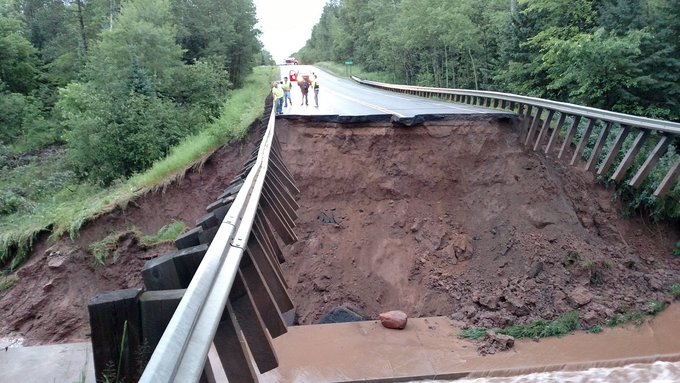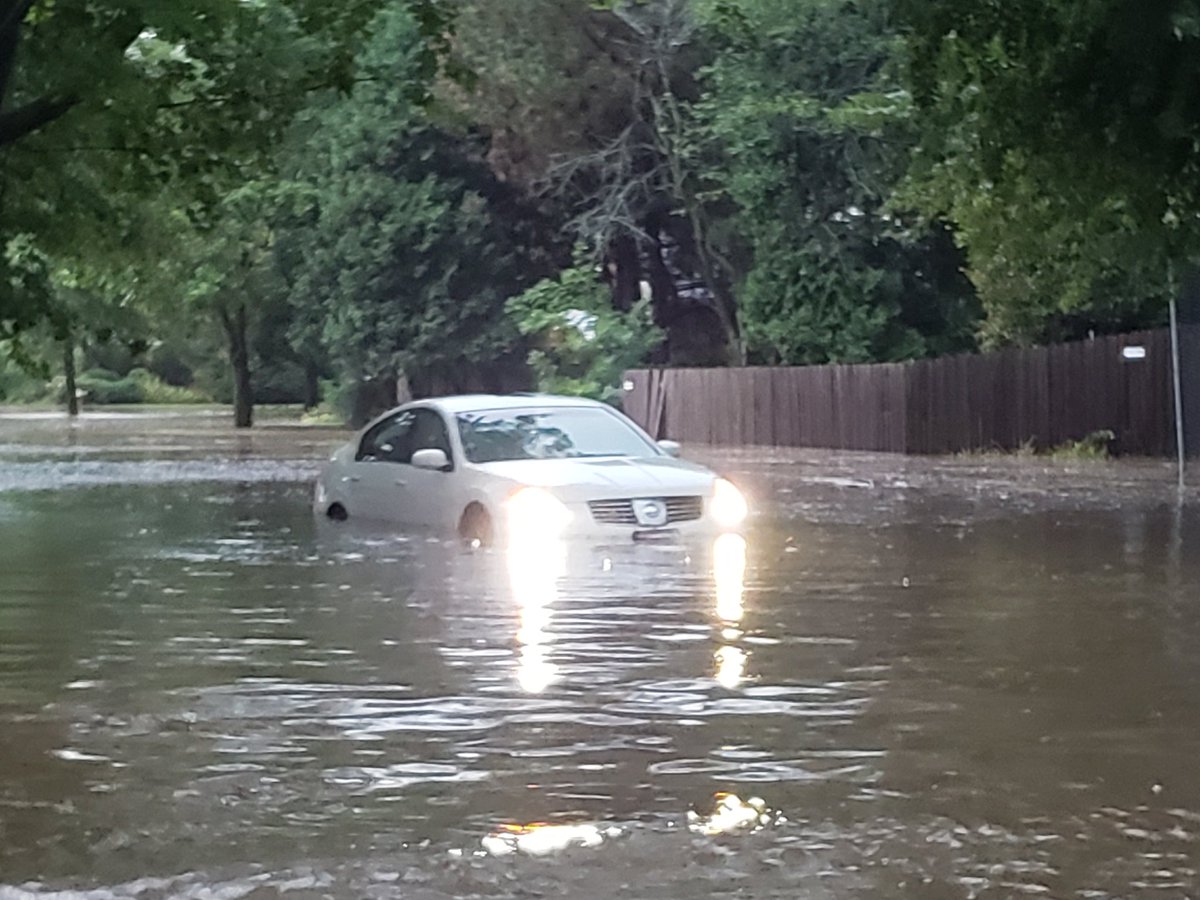[Updated, 11:32 p.m., 8/26/18 and 8/27/18] It's not a secret that Wisconsin GOP Gov. Walker has buried his head in the climate change sand - - along with data and science that could help municipalities facing costly infrastructure damage and people bailing out flooded basements - - and will SE WI join Dane County tonight in that misery? - - better address what keeps flooding frequently and faster across the political and physical environment - - from north - -
- - to south.
Walker and his government obliterated the climate change work of his predecessor Jim Doyle's Task Force on Global Warming, shut down public officials' discussion of climate change, substituted literal fealty on the issue to the Koch brothers, had his Department of Natural Resources delete posted climate change science and data from a key state website, and fired or transferred dozens of DNR climate change experts, thus adding career scrubbing to information scrubbing at a once proud, science-based agency where hand-picked, pro-business managers now serve as a squad of corporate bellhops.
But here's some good news and easy routes to solid information despite Team Walker and their Delete-Key-Pink-Slip-Donor-Friendly behavior:
The Wayback Machine preserves some of the Doyle Task Force work - - here, Global Climate Change.
And here - - Wisconsin Climate Change.
Won't Walker hate this:
With pertinent items like this in an adaptability section:
I'd discovered it 2016, and dating to 2012, I had focused on just how early and deep the scrubbing had gone, with many, many links to climate change resources removed.
I've been focusing lately on my blog in the wake of continual flooding in Wisconsin about the need for good information about the relationship of climate change to flooding to municipal planning and public sector responses.
You can get a feel for just how deeply into the knowledge darkness Walker and his hench-people have cast us by reading below (spoiler alert: prepare for dead links galore) what I am again copying so you can see what's been trashed - - and then decide if that's how you want the government you're paying for to behave:
 |
| Highway 63, Bayfield County, 2016. Major storms also hit the area a year later. |
 |
| Dane County, last weekend |
But here's some good news and easy routes to solid information despite Team Walker and their Delete-Key-Pink-Slip-Donor-Friendly behavior:
The Wayback Machine preserves some of the Doyle Task Force work - - here, Global Climate Change.
And here - - Wisconsin Climate Change.
Won't Walker hate this:
"The scope and consequences of global warming are so massive that the responsibility for action rests not only with our leaders in Washington, but with all of us." Jim Doyle, Governor of WisconsinAlso, while the DNR information scrub deleted the link to the interagency Wisconsin Initiative on Climate Change Impacts the material is very much available, here.
With pertinent items like this in an adaptability section:
WICCI climate models project that Wisconsin will experience increasing temperatures along with more frequent and intense rain events.
Storms that drop two or three inches in a 24-hour period occur today about 12 times per decade in southern Wisconsin, and seven times per decade in northern Wisconsin. By mid-century, these are likely to occur about 25 percent more frequently and increase slightly in intensity.
The frequency of very hot days (over 90°F) will likely double, from roughly 12 per year to 25. Planning ahead for these changes can help communities become more resilient.After all, "impacts" is what's important this days, as WICCI notes:
Climate Wisconsin 2050: New publication provides communities tips to adapt to climate change
WICCI researches potential climate change impacts on Wisconsin natural resources, ecosystems and regions; evaluates potential effects on industry, agriculture, tourism and other human activities; and develops and recommends adaptation strategies that can be implemented by businesses, farmers, public health officials, municipalities, resource managers and other stakeholders. The effort engages citizens, private and public decision-makers, and scientists from Wisconsin and the Upper Midwest.
Read more from Climate Wisconsin 2050: Communities (PDF).Now back to the DNR website scrub so I can make a few more points:
I'd discovered it 2016, and dating to 2012, I had focused on just how early and deep the scrubbing had gone, with many, many links to climate change resources removed.
I've been focusing lately on my blog in the wake of continual flooding in Wisconsin about the need for good information about the relationship of climate change to flooding to municipal planning and public sector responses.
You can get a feel for just how deeply into the knowledge darkness Walker and his hench-people have cast us by reading below (spoiler alert: prepare for dead links galore) what I am again copying so you can see what's been trashed - - and then decide if that's how you want the government you're paying for to behave:
Let's begin with the agency's main Climate Change page, under "Currently in our State,' where you find three short bulleted entries with citations to information released in 2010 or early 2011, including a link to a key Legislative Council Study pdf since removed from the website, and a line about a Jim Doyle task force that produced a bill never brought to a vote in the Legislature. The page does not indicate when it was last updated.
So "Currently" is a bit oxymoronic. Read on...
The Basics page was last updated January 14, 2010.That was then, and this is now:
The Climate Trends page was last updated May 11, 2010.
The Impacts page was last updated January 19, 2010.
The Adaptations page was last updated February 14, 2011.
The Government Initiatives page was last updated on October 7, 2011, but contains a link that goes nowhere, gets you to links supposedly referencing work at the US Environmental Protection Agency - - that actually brings you a gloomy assessment because of GOP-led efforts to block EPA clean air work - - and takes you back to the DNR "initiatives" page that features information from the Doyle administration:
- Expanding the state's existing energy conservation and efficiency programs
- Adopting California vehicle standards for greenhouse gases
- Developing an emission cap and trade program
The Wisconsin Legislative Council prepared summary documents related to the Task Force recommendations, including:
- Establishing a formal process to track progress, evaluate existing policies and recommend adjustments
Finally, at the Roles page, the DNR defines itself again through the work of the Doyle administration, leading with, at "What The DNR is Doing":
- An information memo summarizing the Task Force recommendations [exit DNR]
Oh - - if you click through to the link "Wisconsin initiatives," you're referenced right back to a DNR page that also led with work from the Doyle era:
- Expanding the state's existing energy conservation and efficiency programs
- Adopting California vehicle standards for greenhouse gases
- Developing an emission cap and trade program
The Wisconsin Legislative Council prepared summary documents related to the Task Force recommendations, including:
- Establishing a formal process to track progress, evaluate existing policies and recommend adjustments
- An information memo summarizing the Task Force recommendations [exit DNR.
Documenting WI Gov. Walker's attacks on science, climate changeAnd by the way, other Great Lakes states are not following Walker's lead.
No comments:
Post a Comment